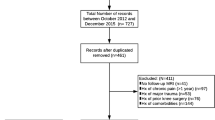Abstract
Inaccurate femoral tunnel placement has been identified as one of the most frequent errors in failed anterior cruciate ligament reconstructions. Most surgeons evaluate the femoral tunnel position on plain radiographs but in a lot of cases it is difficult to detect the femoral tunnel. The goal of this study was to compare plain digital radiographs and multiplanar computed tomography (CT) scans for the evaluation of femoral tunnel position. We examined 50 patients 24–60 months postoperatively, following an arthroscopically-assisted anterior cruciate ligament reconstruction with central third bone–patellar tendon–bone graft. Endobutton fixation was used on the femoral side and titanium interference screws on the tibial side. Standard antero-posterior and lateral X-rays and a CT scan were obtained from each patient. Sagittal and frontal reconstructions of the CT scan were used for the evaluation. We measured the height of the center of the tunnel in the notch in the frontal plane, and the position of the tunnel along Blumensaat’s line (BL) in the lateral plane. Measurements are reported as percentages of total notch height and of the length of BL. On plain X-rays the tunnel was invisible in 46 cases in the anterior–posterior plane and in eight cases on the lateral plane. The average position in the frontal plane was 89.8%, and in the lateral plane 38.6%. In the CT scans, measurements were able to be done in 48 patients. The frontal-plane position averaged 90.5% and the lateral-plane position 34.1%. Pearson’s correlation coefficient for the values in the lateral plane for CT and X-rays was low at 0.22, with p>0.05. In our group of 50 patients we were able to detect the femoral tunnel on both plains of standard X-rays in only four patients, whereas it was possible to take accurate measurements in 48 patients on reconstructed CT scans. We advocate the use of CT technology for the evaluation of femoral position whenever precise measurements are needed.








Similar content being viewed by others
References
Amis AA, Beynnon B, Blankevoort L et al (1994) Proceedings of the ESSKA scientific workshop on reconstruction of the anterior and posterior cruciate ligaments. Knee Surg Sports Traumatol Arthrosc 2:124–132
Arnold MP, Kooloos J, van Kampen A (2001) Single-incision technique misses the anatomical femoral anterior cruciate ligament insertion: a cadaver study. Knee Surg Sports Traumatol Arthrosc 9:194–199
Bagnolesi P, Russo R, Battolla L et al (1994) Reconstruction of the anterior cruciate ligament with patellar tendon. Comparison between magnetic resonance and computerized tomography. Radiol Med (Torino) 88:378–387
Feagin JA Jr (1979) The syndrome of the torn anterior cruciate ligament. Orthop Clin North Am 10:81–90
Girgis FG, Marshall JL, Monajem A (1975) The cruciate ligaments of the knee joint. Anatomical, functional and experimental analysis. Clin Orthop 106: 216–231
Hefzy MS, Grood ES, Noyes FR (1989) Factors affecting the region of most isometric femoral attachments. Part II: the anterior cruciate ligament. Am J Sports Med 17:208–216
Hoogland T, Hillen B (1984) Intra-articular reconstruction of the anterior cruciate ligament. An experimental study of length changes in different ligament reconstructions. Clin Orthop 185:197–202
Howell SM, Gittins ME, Gottlieb JE, Traina SM, Zoellner TM (2001) The relationship between the angle of the tibial tunnel in the coronal plane and loss of flexion and anterior laxity after anterior cruciate ligament reconstruction. Am J Sports Med 29:567–574
Insall J, Joseph DM, Aglietti P, Campbell RD Jr (1981) Bone-block iliotibial-band transfer for anterior cruciate insufficiency. J Bone Joint Surg Am 63:560–569
Khalfayan EE, Sharkey PF, Alexander AH, Bruckner JD, Bynum EB (1996) The relationship between tunnel placement and clinical results after anterior cruciate ligament reconstruction. Am J Sports Med 24:335–341
Lintner DM, Dewitt SE, Moseley JB (1996) Radiographic evaluation of native anterior cruciate ligament attachments and graft placement for reconstruction. A cadaveric study. Am J Sports Med 24:72–78
Melhorn JM, Henning CE (1987) The relationship of the femoral attachment site to the isometric tracking of the anterior cruciate ligament graft. Am J Sports Med 15:539–542
Muneta T, Yamamoto H, Sakai H, Ishibashi T, Furuya K (1993) Relationship between changes in length and force in in vitro reconstructed anterior cruciate ligament. Am J Sports Med 21:299–304
Odensten M, Gillquist J (1985) Functional anatomy of the anterior cruciate ligament and a rationale for reconstruction. J Bone Joint Surg Am 67:257–262
Shelbourne KD, Whitaker HJ, McCarroll JR, Rettig AC, Hirschman LD (1990) Anterior cruciate ligament injury: evaluation of intraarticular reconstruction of acute tears without repair. Two to seven year followup of 155 athletes. Am J Sports Med 18:484–488
Shellock FG, Mink JH, Curtin S, Friedman MJ (1992) MR imaging and metallic implants for anterior cruciate ligament reconstruction: assessment of ferromagnetism and artifact. J Magn Reson Imaging 2:225–228
Sim E (1993) Choice of femoral reinsertion sites after rupture of the anterior cruciate ligament—a roentgenologic evaluation model. Aktuelle Traumatol 23:330–331
Sim E (1994) Transcondylar reinsertion of femoral avulsions of the anterior cruciate ligament: evaluation of the position in 20 cases using three-dimensional computed tomographic reconstruction. J Trauma 37:525–531
Sommer C, Friederich NF, Muller W (2000) Improperly placed anterior cruciate ligament grafts: correlation between radiological parameters and clinical results. Knee Surg Sports Traumatol Arthrosc 8:207–213
Tomczak RJ, Hehl G, Mergo PJ, Merkle E, Rieber A, Brambs HJ (1997) Tunnel placement in anterior cruciate ligament reconstruction: MRI analysis as an important factor in the radiological report. Skeletal Radiol 26:409–413
Author information
Authors and Affiliations
Corresponding author
Rights and permissions
About this article
Cite this article
Hoser, C., Tecklenburg, K., Kuenzel, K.H. et al. Postoperative evaluation of femoral tunnel position in ACL reconstruction: plain radiography versus computed tomography. Knee Surg Sports Traumatol Arthrosc 13, 256–262 (2005). https://doi.org/10.1007/s00167-004-0548-y
Received:
Accepted:
Published:
Issue Date:
DOI: https://doi.org/10.1007/s00167-004-0548-y




